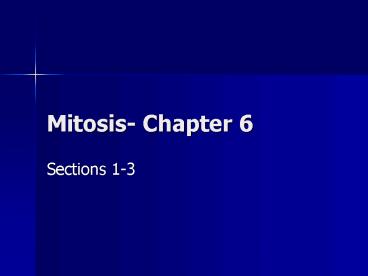Mitosis- Chapter 6 - PowerPoint PPT Presentation
1 / 36
Title:
Mitosis- Chapter 6
Description:
Mitosis- Chapter 6 Sections 1-3 Objectives- Identify four examples of cell division in eukaryotes and one example in prokaryotes. Differentiate between a gene, a DNA ... – PowerPoint PPT presentation
Number of Views:64
Avg rating:3.0/5.0
Title: Mitosis- Chapter 6
1
Mitosis- Chapter 6
- Sections 1-3
2
Objectives-
- Identify four examples of cell division in
eukaryotes and one example in prokaryotes. - Differentiate between a gene, a DNA molecule, a
chromosome, and a chromatid. - Compare haploid and diploid cells.
- Differentiate between homologous chromosomes,
autosomes, and sex chromosomes. - Predict how changes in chromosome number or
structure can affect development.
3
Why do cells divide?
- Repair
- Growth development
- Make gametes (sex-cells sperm or egg)
4
Asexual Reproduction
- Reproduction by
- Binary Fission
- Fragmentation
- Vegetative Propagation
- Genetically identical offspring
- Dont need partner to reproduce
5
Binary Fission
6
Fragmentation
7
Sexual Reproduction
- Reproduction requires gametes
- Genetically different offspring
8
Sexual Reproduction- Simple version
- Daddys sperm meet Mommys egg
- This sperm eats a hole for itself into the egg
to get its DNA in - This fertilized cell is called a zygote
- This zygote divides and grows into a baby by
Mitosis
9
Prokaryotes vs Eukaryotes
- Prokaryotes use asexual reproduction
- Eukaryotes may use asexual OR sexual reproduction
- Prokaryotes reproduce more quickly
- Eukaryotes reproduce more slowly
10
Prokaryotes vs Eukaryotes
11
(No Transcript)
12
Focus on Eukaryotes (us)
- Gene- part of DNA that codes for particular
trait - Chromosome- made of coiled DNA and protein
13
More Important Terms
- Centromere- center point where two chromatids are
attached - Chromatid- half of a chromosome
Chromosome
14
(No Transcript)
15
Eukaryote Cell Division
http//www.cellsalive.com/cell_cycle.htm
16
Cell Cycle
S phase (DNA synthesis chromosome duplication)
- Consists of
- Interphase
- Mitosis
Interphase (90 of time)
G1
G2
Mitotic phase (M) (10 of time)
Mitosis
Cytokinesis
17
(No Transcript)
18
Interphase
- Cell spends 90 of its time here
- G1- 1st growth phase
- S- synthesis of DNA
- G2- 2nd growth phase
- There are checkpoints throughout the cell cycle
19
Mitosis- (growth/repair)
- Begins with 1 diploid cell, ends with 2 diploid
cells - Diploid twice the number of chromosomes (2N)
- One chromosome set comes from mom, the other from
dad - All of our body cells are diploid (except for
sperm and egg)
Remember produces 2 genetically identical cells!
20
Basic Steps of Mitosis
- PMAT
- P- Prophase
- M- Metaphase
- A- Anaphase
- T- Telophase
21
Prophase
- Nuclear membrane dissolves
- Chromosomes become visible
22
Metaphase
- Chromosomes align on the equator
- Spindle fibers form and attach to centromere
23
Anaphase
- Centromeres break
- Chromatids move toward the poles as spindle
fibers shorten
24
Telophase
- Nuclear envelope forms
- Cleavage furrow in animals
- Cell plate in plants
- Daughter cells form when Cytokinesis (cell splits
into two) occurs
25
Cleavage Furrow
26
Cell Plate
27
When Mitosis goes bad
- Cell Cycle checkpoints dont work properly
- Cell can divide when it shouldnt
- Cell can mutate
- A benign (harmless) tumor can form
- Cancer may develop
28
Cell Cycle CheckPoints
29
What is Cancer?
- Named for organ or tissue where its found
- Cells that divide out of control due to a
mutation in the DNA - These out of control cells can destroy/invade
normal cells and tissues - Cancer can spread from a malignant (harmful)
tumor - Metastasis is cancer cells that have spread
30
(No Transcript)
31
Figure 12-17x1 Breast cancer cell
32
(No Transcript)
33
Common Types of Cancer
34
Cancer Treatment
- Radiation can be used for skin cancer
- Chemotherapy involves drugs that stop Mitosis
throughout the body - Chemotherapy drugs not only try to kill cancer
cells but it makes wounds slower to heal, hair to
be lost, immune system to be weakened
35
Cancer Caution Signs
- Change in potty habits
- A sore that does not heal
- Unusual bleeding or discharge
- Thickening of tissue or new lump
- Indigestion
- Obvious changes to moles or warts
- Nagging cough that lasts for a month or more
36
Cancer Prevention-what YOU can do
- Not smoking
- Limiting time in the sun
- Eating high-fiber, low-fat diet
- Visit Doctor regularly
- Perform regular self-examinations































